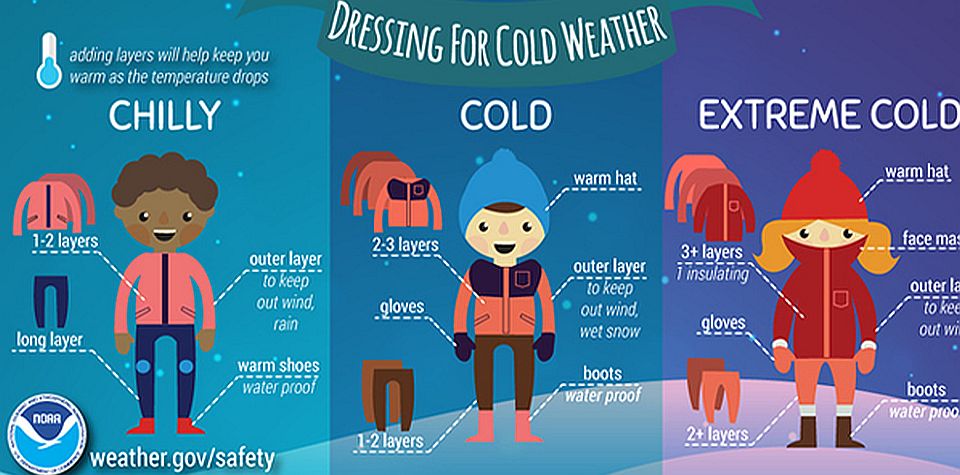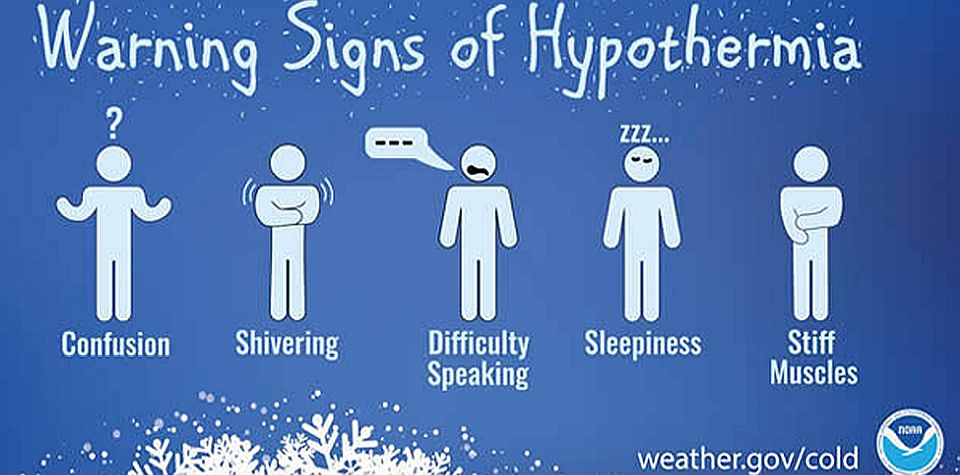Cold Weather & the Polar Vortex and How to Stay SAFE
Winter Weather Safety Winter Survival Kit
– For your car: Warm clothes, blanket, food, water, cell phone/charger
– For your home: Food, water, medication, flash light, first aid kit
Extremely cold air comes every winter in at least part of the country and affect millions of people across the United States. The arctic air, together with brisk winds, can lead to dangerously cold wind chill values. People exposed to extreme cold are susceptible to frostbite in a matter of minutes. Areas most prone to frostbite are uncovered skin and the extremities, such as hands and feet.

Image courtesy weather.gov
Frostbite can happen in minutes, especially on the extremities such as fingers, toes, nose and ears but can affect any area of exposed skin. If you suspect frostbite, immediately move inside to a heated location and begin warming the affected areas using warm water or body heat. Do not use hot water or radiant heat such as a fireplace since affected areas can be easily burned. Seek medical attention for severe frostbite.
Frostbite happens when the body’s survival mechanisms kick in during extremely cold weather. To protect the vital inner organs, the body cuts circulation to your extremities: feet, hands, nose, etc., which eventually freeze. To avoid frostbite, stay inside during severe cold, especially when the windchill is -50°F or below. If you must go out, try to cover every part of your body: ears, nose, toes and fingers, etc. Mittens are better than gloves. Keep your skin dry. Stay out of the wind when possible. Drink plenty of fluids since hydration increases the blood’s volume, which helps prevent frostbite. Avoid caffeine, alcohol and cigarette. Caffeine constricts blood vessels, preventing warming of your extremities. Alcohol reduces shivering, which helps keep you warm. Cigarettes shut off the blood flow to your hands. Below are indicators of frostbite:
- First degree: Ice crystals are forming on your skin.
- Second degree: Skin begins to feel warm even though it is not yet defrosted.
- Third degree: Skin turns red, pale or white.
- Fourth degree: Pain lasts for more than a few hours and skin may develop dark blue or black. See a doctor immediately if these symptoms arise. Gangrene is a real threat.
First Aid for Frostbite
Get indoors as quickly as possible. Until you can get indoors:
- Don’t rub or massage cold body parts.
- Put your hands in your armpits.
- Hold onto another person or animal.
- Drink warm liquids.
- Put on extra layers of clothes, blankets, etc.
- Remove rings, watches and anything other tight jewelry or related items.
Once indoors:
- Don’t walk on a frostbitten foot. You could cause more damage.
- Get in a warm, NOT hot, bath and wrap your face and ears in a moist, warm, NOT hot, towel.
- Don’t get near a hot stove or heater or use a heating pad, hot water bottle, or a hair dryer. You may burn yourself before feeling returns.
- Frostbitten skin will become red and swollen and feel like it’s on fire. You may develop blisters. Don’t break the blisters. It could cause scarring and infection.
- If your skin turns blue or gray, is very swollen, blistered or feels hard and numb even under the surface, go to a hospital as soon as possible.
Hypothermia is another threat during extreme cold. Hypothermia occurs when the body loses heat faster than it can produce.

Image courtesy weather.gov
When your body temperature sinks below 96°F, you have hypothermia, a serious health hazard that occurs when body temperature is lowered too much. Get medical attention immediately. Move the victim inside to a heated location and begin warming the center of the body first. If the person is unconscious, administer CPR.
Hypothermia can occur in temperatures as warm as 60°F, particularly in water or with if you are outside a long time and not dressed for the weather. Of the approximately 1,300 people the CDCP lists as being killed by hypothermia each year, most are seniors, according to the National Institute of Aging, but some are children and young adults. Everyone needs to be careful. Some medicines, problems with circulation, and certain illnesses may reduce your ability to resist hypothermia. As you age, your body becomes less efficient at letting you know when you are too cold. In addition, older people tend not to shiver effectively, one of the ways the body warms itself up. Remember these tips to help prevent hypothermia:
- Dress in layers
- Wrap up well when going outside in the cold.
- Avoid breezes and drafts indoors.
- Eat nutritious food and wear warm clothes to ward off winter chill.
- Wear a warm hat in the winter.
- Eat hot foods and drink warm drinks several times during the day.
- If you live alone, ask a family member of neighbor to check on you daily or have a camera installed that a family member can view on their computer.
- Ask your doctor if any medicine you’re taking increases your risk of hypothermia. Drugs that may cause a problem include barbiturates, benzodiazepines, chlorpromazine, reserpine, and tricyclic antidepressants.
If your temperature is 96°F or less, you feel cold and sluggish, or are having trouble thinking clearly, see your doctor immediately or go to the nearest emergency room. It’s better to be overly cautious than to die of a disorder that doesn’t have to be deadly.
First Aid for Hypothermia
If you are trying to help someone who may have hypothermia, first call an ambulance. Then lie close to the person and cover both of you with thick blankets. The hotter you get, the more warmth you can give the other person. Don’t rub the person or handle him or her roughly.
Cold weather can also affects crops. In late spring or early fall, cold air outbreaks can damage or kill produce for farmers, as well as residential plants and flowers. A freeze occurs when the temperature drops below 32°F. Freezes and their effects are significant during the growing season. Frost develops on clear, calm nights and can occur when the air temperature is in the mid-30s. Each plant species has a different tolerance to cold temperatures.
————————————————————
COLD WEATHER AND THE POLAR VORTEX
The polar vortex is a large area of low pressure and cold air surrounding both of the Earth’s poles. It ALWAYS exists near the poles, but weakens in summer and strengthens in winter. The term “vortex” refers to the counter-clockwise flow of air that helps keep the colder air near the Poles. Many times during winter in the northern hemisphere, the polar vortex will expand, sending cold air southward with the jet stream. This occurs fairly regularly during wintertime and is often associated with large outbreaks of Arctic air in the United States. The one that occurred January 2014 is similar to many other cold outbreaks that have occurred in the past, including several notable colder outbreaks in 1977, 1982, 1985 and 1989.
There are several things the polar vortex is NOT. Polar vortexes are not something new. The term “polar vortex” has only recently been popularized, bringing attention to a weather feature that has always been present. It is also not a feature that exists at the Earth’s surface. Weather forecasters examine the polar vortex by looking at conditions tens of thousands of feet up in the atmosphere; however, when we feel extremely cold air from the Arctic regions at Earth’s surface, it is sometimes associated with the polar vortex. This is not confined to the United States. Portions of Europe and Asia also experience cold surges connected to the polar vortex. By itself, the only danger to humans is the magnitude of how cold temperatures will get when the polar vortex expands, sending Arctic air southward into areas that are not typically that cold.
In short, there is no cause to be alarmed when you hear about the polar vortex, but you should be prepared for colder temperatures.
————————————————————
ENERGY SAVING TIPS
Tips on how to use energy as efficiently as possible to help manage the impact extreme weather has on monthly energy costs.
- Check for drafts around windows and doors and seal up any openings with weather stripping or even a rolled-up blanket. A drafty house lets warm air escape and is much more costly to keep warm—especially on the coldest days of the season.
- Keep the fireplace damper closed tightly when not in use.
- Keep heating vents clean with a vacuum or broom and do not cover ducts with drapes or furniture that can block the airflow and possibly cause a fire.
- Use ceiling fans so the warm air that has risen can be redistributed around the room.
- Close off unoccupied rooms and regulate individual room temperatures if possible.
- Keep your thermostat set at a constant, comfortable level—usually 68-70 degrees. You can save 3 percent on your heating costs for every degree you reduce the temperature below 70 degrees.
- Replace the filter for your heat pump or furnace. Dirty filters block airflow and force equipment to work harder—this increases operating costs and can cause damage.
- Wrap water heaters with an insulation blanket. These blankets are inexpensive and easy to install.
- Remember to turn off unnecessary lights and other electronics.
All information from NOAA/weather.gov and Delmarva Power


